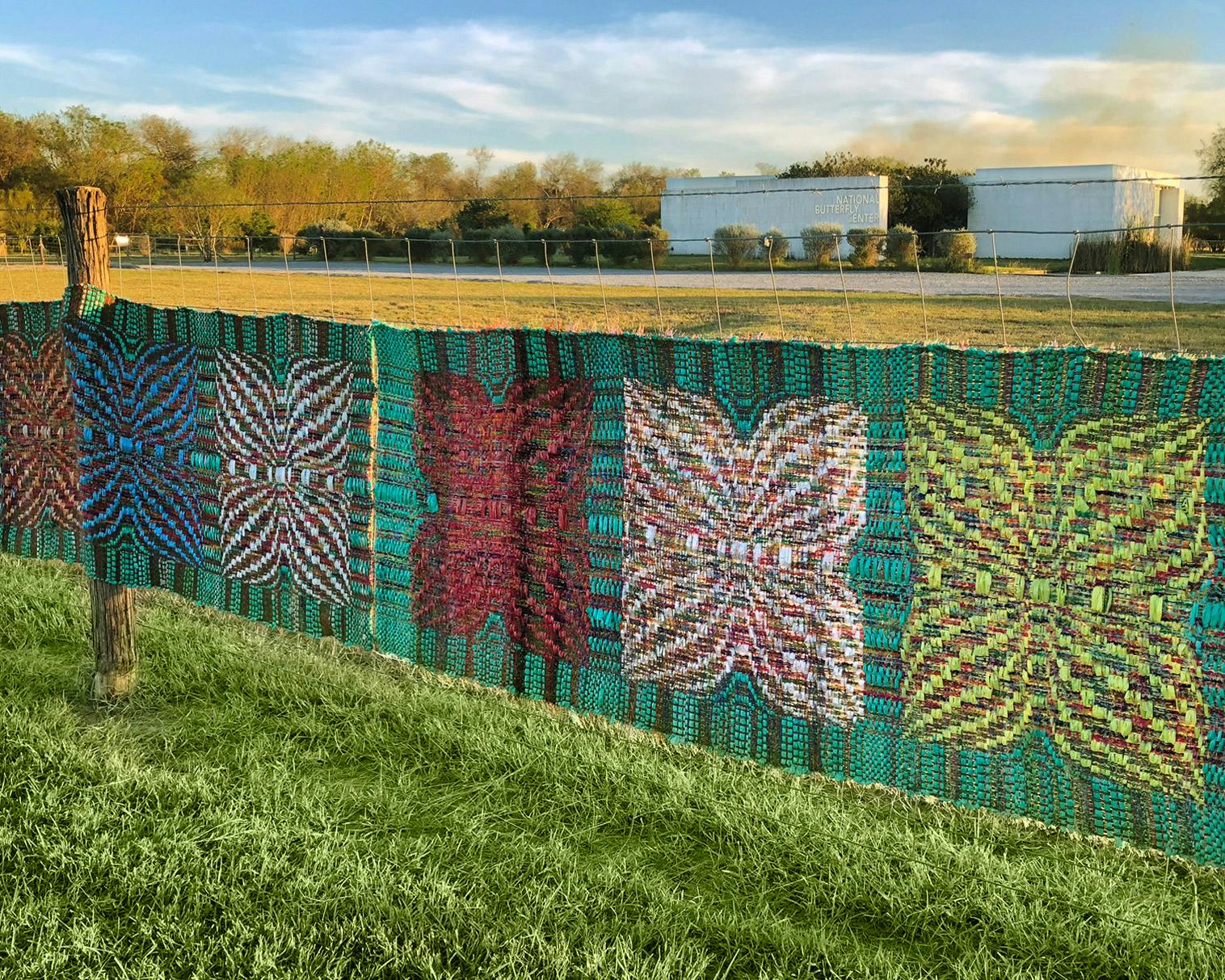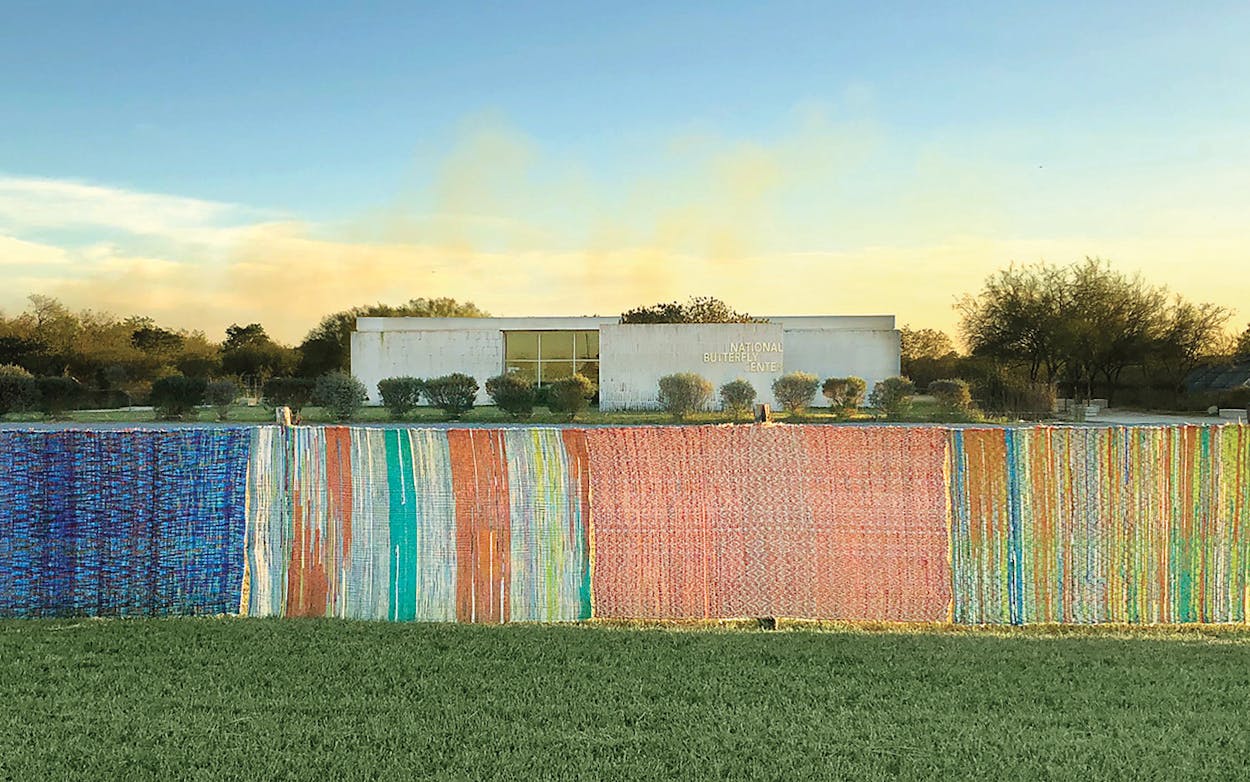When artist Doerte Weber first contemplated an art installation drawing comparisons between the U.S.-Mexico border barrier and the Berlin Wall, she felt like a voice in the wilderness. Despite repeated attempts to partner with educational institutions, private landholders, and public lands, the San-Antonio based artist couldn’t find a home for a long-term installation near the existing border fence in the Rio Grande Valley. “Everybody just said no, we don’t want you, you can’t put it up even temporarily,” Weber says.
That was four years ago. Today, Weber’s Checkpoint Carlos stands at the National Butterfly Center in Mission on the banks of the Rio Grande. The work, woven using bright plastic recycled newspaper bags, is presented in two sections. Indoors is a floor-to-ceiling woven depiction of a modern-day border fence, recognizable to anyone who lives around the existing barriers in the Rio Grande Valley. Several additional tapestry panels are affixed to fences outside, featuring bright geometric patterns.
Weber’s weavings are meant, in part, to evoke the colorful graffiti on the West side of the Berlin Wall that she would pass in her early twenties, crossing between East and West Berlin. For Weber, the graffiti served as a reminder of hope and humanity in the face of stark division. The title of her piece also alludes to the border of her youth with a nod to “Checkpoint Charlie,” the most famous militarized Cold War crossing between East and West Berlin.
In early 2015, Weber installed Checkpoint Carlos alongside the U.S.-Mexico border wall without official permission, took a few pictures, and had to take it down the same day. (She later showed the panels in the non-profit gallery Artpace in San Antonio in 2017.) Since then, times have changed in the Valley.
“It’s interesting to see how in such a short time period—four years—the minds of people have changed,” Weber says. “Now people more and more think it’s a real wall, and it’s the same as what other people have experienced in other countries.”


This time, Weber’s work is up semi-permanently, and it has received enthusiastic responses on social media. That includes a popular Facebook post from Weber’s brother-in-law decrying proposed new wall construction near and through the Butterfly Center as a “federal land grab.” It’s unclear if the Butterfly Center—a 100-acre non-profit nature preserve and education center—could survive losing 70 percent of its land to the other side of the wall.
One reason that Weber’s provocative work is now welcome on the border is a breakdown in goodwill between U.S. Customs and Border Protection, or CBP, and local landowners, including the Butterfly Center. “We used to have a mutually beneficial, mutually cooperative relationship with Border Patrol,” says Marianna Treviño-Wright, director of the Butterfly Center. But Treviño-Wright characterizes her recent experiences with CBP as “hostile and destructive, uncommunicative and unsupportive.” She paints a picture of a total breakdown in communication with uniformed government personnel, who no longer seem to worry about destroying private property or respecting the concerns of local landowners.
“The way they behave now ensures I would rather deal with traffickers,” says Treviño-Wright, who explains that Border Patrol has removed her gates and locks an estimated eight to ten times in recent years, that Border Patrol damaged her sprinkler systems, and that a hot truck parked on dry grass started a wildfire. She also claims that at least eight Border Patrol officers launched “an all-out tactical raid on a bunch of little Girl Scouts,” accidentally targeting a pre-scheduled Butterfly Center tour group instead of intercepting smugglers. According to Treviño-Wright, the raid involved visible machine guns, two all-terrain vehicles, two SUVs, and a helicopter. Butterfly Center director of operations Max Muñoz backs up all of Treviño-Wright’s claims, speculates that the wildfire in question might have been caused either by a hot vehicle parked in high grass or a CBP officer’s cigarette, and confirms that he was leading the Girl Scout troop at the time of the raid.
“It is with complete certainty in years past, agents have entered on the Butterfly Center’s property to investigate illegal entries, apprehend illegal aliens and seize narcotics,” a Border Patrol spokesperson emailed Texas Monthly in response to Treviño-Wright’s allegations. “The U.S. Border Patrol has a vested interest in keeping an open communication with landowners to mitigate any issues that property owners may have with Border Patrol operations. There are no reports in our records that substantiate a ‘raid’ against girl scouts on the Butterfly Center property… CBP takes all allegations of misconduct seriously and investigates all reported allegations.”
Weber’s weavings of course, predate these specific complaints of Border Patrol misconduct in the Valley. Her statement with the installation is as much about the present day as about her native Germany, which she left in 1984. (After traveling for a couple of years, she settled in the U.S. and later married a Texan.) Yet her work takes on new meaning in the current political climate.
Ordinarily, when guests enter the Butterfly Center’s visitor pavilion, they would encounter, through a glass facade, a bucolic view of gardens, restored native habitat, and, with luck, fluttering wildlife. Now, Weber’s tall panels depicting the border barriers block the view, casting the space in half-light. The outdoor panels, some of which are repurposed from a project Weber installed at a hospital in San Antonio, suggest butterflies while also evoking the orange safety netting installed around urban construction zones.

The work serves as a stark reminder of the changes about to be wrought in steel and concrete. “The impact visually, never mind environmentally, that the wall will make in the landscape is now physically present and obvious to people who didn’t think it was a big deal to have their view obscured, to have the landscape bisected, to be looking at something ugly, where before there was something beautiful and inviting,” Treviño-Wright says.
The use of plastic newspaper bags as a medium is also a compelling factor in the meaning and impact of “Checkpoint Carlos.” It connects the modern-day wall-building project to political propaganda as played out in the media, inviting us to think about how the news we consume can have tangible effects in the world around us. The plastic itself reads as an affront to nature, a synthetic, environmentally harmful material that will outlast our lifetimes.
In mid-February, U.S. Congress extended what appeared to be a reprieve to the Butterfly Center, specifically protecting it from imminent wall-building. But the presidential declaration of national emergency that accompanied the bill’s signing immediately undermined those protections. For now, the future of the Butterfly Center will depend on both executive whims and the protections of the federal courts.
Weber, for her part, is proud of the impact of her work, even if the wall-building continues. “It makes me very happy that, even though it is still happening, at least we fought,” she says. “At least we didn’t just say, ‘Oh well, we lost it.’ We did our little, tiny little piece of protest. We put it up.” Weber adds that she’s similarly inspired when she sees border residents and tourists taking pictures of the installation.
Weber, who is now developing plans to take Checkpoint Carlos to an exhibition in Berlin this summer, hopes that the outdoor segment of the installation can also serve as a reminder of another lesson she learned from her experience growing up in Cold War Germany—that no wall is permanent. Though she stresses that she will take care to ensure that the plastic does not degrade to the point where it is an environmental hazard, Weber hopes to keep the butterflies up until they begin to, in a sense, metamorphose.
“We are actually thinking of leaving it up until it disintegrates,” Weber says. “That’s part of the statement—that walls go up, and walls will come down. Nature will take its course on them, like it has happened in Europe.”
- More About:
- Art
- Border Patrol
- Mission






